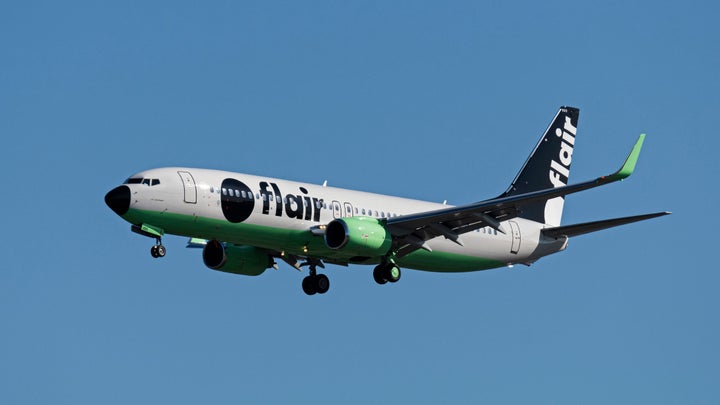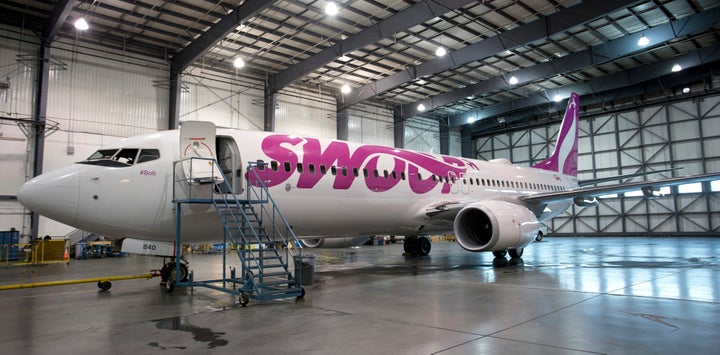This week, Edmonton-based budget airline Flair announced a first for Canada — an all-you-can-fly pass for a flat rate.
For one fee, customers can fly anywhere they want through Flair’s seven operating cities between Feb. 13 and May 13, 2020.
The Go Travel Pass starts at $499 (plus taxes and fees) but comes with blackout dates and excludes Friday and Sunday travel. For $699 (plus taxes and fees), you can fly on any of their included flights during that period and check one bag each time. The travel passes are available online and on sale until Feb. 12 at midnight, based on availability.
“Whether you are a student who needs to visit home, a small business owner on a budget, a family needing to connect or an adventure seeker looking for your next thrill, all Canadians deserve to travel without hesitation,” director of commercial for Flair Airlines, Sarah Riches, said in a press statement.

Flair operates in Abbotsford, Edmonton, Calgary, Kelowna, Toronto, Vancouver and Winnipeg.
And it is generally cheaper than its competition. A round-trip flight from Calgary to Toronto can average around $400 on its own. Excluding any extra fees, two trips across Canada on the unlimited pass would more than pay for itself.
It follows a sale earlier this month from WestJet offshoot Swoop, which unveiled a so-called loonie sale, offering up to 100,000 seats for a base fare of $1 before taxes and fees.
So how is an unlimited travel pass or flight across Canada for $1 even possible? Well, it starts with the add-ons.
Bills, bills, bills
The biggest way is by keeping costs down, and if you’ve flown on a budget carrier, you’ll know where that starts — fees.
Budget airlines like Flair and Swoop are built on a successful model pioneered by Ireland’s Ryanair in Europe. Flights offered as cheaply as possible plus expensive add-ons lead to low fares.
Fees for bags, for seat selection and internet. Fees to change your booking, get a window seat or buy a water on board. So even if you’re flying on the unlimited travel pass, you could incur a host of fees on each individual flight if you aren’t willing to let the airline assign you a seat and only travel with limited luggage. It’s all part of the model.
“We’ve stripped back every costly addition to help more people fly for less. That means you only pay for what you want,” Flair says right on their website.
WATCH: The fastest growing airlines are low-budget carriers. Story continues below.
Trim the fat
Budget airlines also work to trim costs from every part of their operation. Often more seats are packed onto each plane, and amenities like seat-back televisions aren’t included. Nor are space-sucking options like first class or business class on the table. A budget airline is, in many ways, a bus with wings.
They also often operate out of airports with cheaper airport fees (here’s looking at you Abbotsford and Edmonton, where Flair started out) and work to save money on fuel through something called fuel hedging, where they gamble on fuel prices when the price is low.
You’ll also notice that Flair doesn’t really do connections. That’s because of the logistical costs of flying from Toronto to Calgary to Kelowna, for example. It’s a lot easier just to pack as many direct flights as possible in, rather than deal with complex connections and the work associated with them.
Low costs also start with the airplanes themselves. Rather than operating a variety of different aircraft from Boeing and Airbus like WestJet or Air Canada, Flair operates a fleet of 10 Boeing 737s from the 400 series and 800 series. Similarly, Swoop offers a fleet of 10 Boeing 737-800s.

Restricting the type of aircraft means less training for staff and a greater ability to shift crews and maintenance staff across the whole fleet, instead of cross-training crew on safety and operation across different vehicles. It also means they only have to stock replacement parts for one type of airplane.
And this consistency leads to faster turn-arounds, which in turn leads to more flights and more money for the company.
Where and when is everything
The timing of deals like the unlimited travel pass also plays into savings. The pass is available from February to May — a time period when people aren’t really travelling as much as they do around the winter holidays or in the summer.
“Everybody travels at Christmas. Everybody travels when the weather’s warm ... but when the temperature goes down, people tend not to travel as much domestically,” Flair executive Jim Scott told the Canadian Press.
“If you have seats that are not full, how do you stimulate people to travel more? You just say, ‘Pay for a pass and then travel for the full 90 days.’”
Similarly, Swoop’s “loonie sale” was specifically targeted at the one route where the two budget airlines overlap, as a way to poach prospective customers.
“If you have seats that are not full, how do you stimulate people to travel more?”
- Flair Airlines chief executive Jim Scott
About 32 per cent of the seats under the deal are on the routes connecting Abbotsford and Edmonton, out of about 45 routes with $1 fares, according to a Flair submission to the Competition Bureau last month obtained by the Canadian Press.
A Swoop spokesperson confirmed to the Canadian Press that loonie fares were “readily available” on the Edmonton-Abbotsford route, as it is the highest-frequency route with 16 flights per week in the winter and 24 flights per week in the summer.
May the odds be ever in your favour
Budget airlines also force competitors to match their prices.
In 1993, researchers at the United States Department of Transportation analyzed trends in airline prices and coined something called the “Southwest effect,” referring to the impact of low-cost carrier Southwest Airlines on forcing down the prices of competitors. It lasts today, too. A recent study showed one-way fares are an average of $45 lower when Southwest serves a market with nonstop flights.
WestJet was once the young gun budget airline entering the market. But now, for the most part, its prices are similar to Air Canada, across the board. With budget carriers entering the market, though, legacy carriers will have to either lower their prices to be more competitive, or differentiate service to make the price difference worthwhile.
And the fight has gotten nasty. Beyond the seemingly targeting of the loonie fares from Swoop, in 2018, Flair went to Canada’s competition watchdog alleging that WestJet had engaged in predatory pricing to force the upstart budget airline out of small markets.
“Whenever we go into a market, WestJet or Swoop [which is owned by WestJet] will go into the same market with a lot of inventory, low-cost,” Flair chief executive Jim Scott said at the time.
“This is a case of David and Goliath. We’re here trying to provide a service to Canadians, and the entrenched incumbent is basically trying to keep a new player out of the marketplace.”
With an initiative like the Go Travel Pass, Flair is likely hedging its bets on converting regular customers from other airlines to offset the cheap price. There’s a perfect equilibrium where core customers at a cheaper price still equals profit. Flair is likely hoping to find that.
With files from the Canadian Press